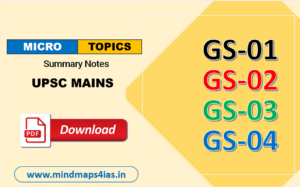Subject: Economy, Social Issues
Relevance: The Time Use Survey is important for UPSC as it provides insights into the care economy, gender statistics, and unpaid work, all of which are relevant for understanding socio-economic dynamics and policy-making.
Why in the News?
-
The National Statistics Office (NSO) under the Ministry of Statistics and Programme Implementation (MoSPI) released the second All-India Time Use Survey for the period January-December 2024.
Key Takeaways
-
Purpose of the Time Use Survey (TUS):
-
Measures time dispositions of the population on different activities.
-
Captures time spent on paid, unpaid, and other activities.
-
Provides details on time spent on learning, socializing, leisure, self-care, etc.
-
-
Significance of TUS:
-
Different from other household surveys as it captures time disposition on various human activities.
-
Helps measure various aspects of gender statistics.
-
-
Findings of the TUS 2024:
-
Females spent 289 minutes per day on unpaid domestic services in 2024 (reduced by 10 minutes from 2019).
-
Females spent 201 minutes more than males on unpaid domestic services.
-
Females spent 137 minutes per day on unpaid caregiving for household members (increased from 134 minutes in 2019).
-
Females spent 62 minutes more than males on unpaid caregiving.
-
41% of females aged 15-59 participated in caregiving, compared to 21.4% of males.
-
Males spent 132 minutes more than females on employment and related activities.
-
83.9% of females participated in unpaid activities, almost the same as in 2019 (84.0%).
-
Participation of females in paid activities increased to 20.6% (from 17.1% in 2019).
-
Participation of males in unpaid activities increased to 45.8% (from 43.9% in 2019).
-
Participation of males in paid work increased to 60.5% (from 54.8% in 2019).
-
For socializing and communication, community participation, and religious practice, females spent the same amount of time at 139 minutes in both 2024 and 2019, males reduced their time for such activities to 138 minutes from 147 minutes.
-
-
Paid vs. Unpaid Activities (Definitions):
-
Paid work: Self-employment for production of goods/services; regular wage/salary/casual labor for production of goods/services.
-
Unpaid activities: Care for children, sick, elderly, disabled; production of other services for own consumption; production of goods for own consumption; voluntary work; unpaid trainee work; other unpaid work.
-
Beyond the Nugget: Purple Economy and Care Economy
-
Purple Economy (Care Economy):
-
Recognizes the importance of care work, empowerment, and autonomy of women.
-
Essential for functioning economies, societal well-being, and life sustainability.
-
-
Definition of Care Economy (ILO):
-
Activities related to providing care and support to individuals, households, and communities, including both paid and unpaid work.
-
-
Gender Disparity in Care Economy:
-
Women are disproportionately represented.
-
Women form 70% of workers in health and social sectors, with a gender pay gap of around 28%.
-
-
Economic Contribution of Care Work:
-
Often undervalued and invisible in economic metrics, leading to market failure.
-
Care work contributes around 15-17% of India’s GDP.
-
-
5R Framework (ILO):
-
Framework to improve the efficiency, sustainability, and fairness of care work.
-
Includes:
-
Recognizing unpaid care.
-
Reducing unpaid care.
-
Redistributing unpaid care.
-
Ensuring adequate reward systems for paid care workers.
-
Prioritizing representation of caregivers and care recipients in policy design and evaluation.
-
-
















